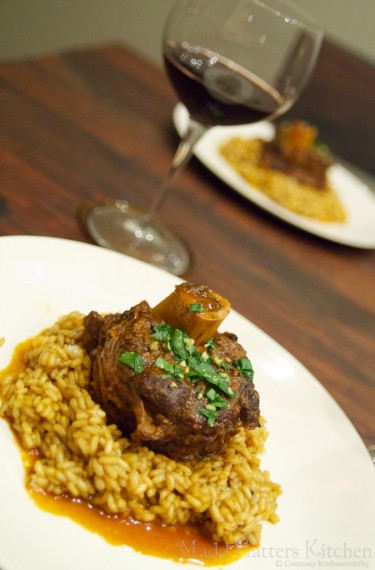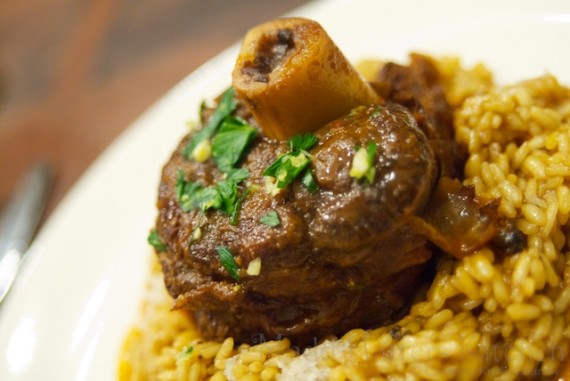Sunday Suppers: Venison Osso Buco & Brunello

Two years ago, I bought a half case of La Fiorita’s riserva brunello di Montalcino. Last year we spaced those bottles out, two over the course of the year, one spring lamb meal paired with the 2001, and one late summer meal of venison and blackberries paired with the 2003. The idea being for a special wine, there must be a special meal!
Most of this year went by, and then bam! I landed some wild boar and venison shanks at the same time. Game pairs amazingly with this wine, and I couldn’t really imagine having anything else with these two meats. So within the course of a month, we enjoyed a wild boar pappardelle, again with the 2003, and then this meal. And this meal may be the hands down best wine pairing I’ve done yet.
The 2003 brunello is much stronger than the 2001, with more of a forward pepper flavor that the 2001 lacks. That has made it a bit more difficult to pair with foods, but I would say the third time is the charm on this wine. The venison osso buco’s velvety sauce, the richness of the venison meat (as compared to a traditional veal osso buco) and of the marrow & saffron risotto tamed the bolder, spicier flavors of this wine.

Venison Osso Buco
Serves 4
2 bay leaves
3 whole cloves
1 sprig fresh rosemary
9 juniper berries
4 venison shanks, cut 3 inches thick
3/4 cup all purpose flour
1/3 cup vegetable oil
1/4 cup extra virgin olive oil
1 1/2 cups finely chopped onion
1/3 cup shredded carrot
1/3 cup finely chopped celery
1 1/2 teaspoons tomato paste
1 can San Marzano tomatoes, crushed
2 cups white wine
7 cups meat stock, preferably beef
1 orange, peel removed in large pieces and juiced
1 lemon, peel removed in large pieces
Sea salt and freshly ground pepper
For gremolata:
1 tablespoon finely chopped Italian parsley
1 plump garlic clove, finely minced
Zest of small lemon, finely shredded
Place the bay leaves, cloves, rosemary, and juniper berries in a piece of cheesecloth and tie.
Place the venison shanks on a plate, standing on their cut ends. Tie each shank with a piece of kitchen twine tightly around their center, which will keep the meat from falling off the bone as it becomes tender. Trim the ends of the twine if needed. Salt the shanks lightly, with about 1/2 teaspoon of sea salt. Dredge the shanks in flour, covering all sides of the shank thoroughly.
Heat the vegetable oil over medium high heat in a dutch oven. Shaking off the excess flour, place all of the shanks into the hot oil, standing on their cut ends. Brown each side well, 3 to 5 minutes each side. You will do this not only for the cut sides, but around the edges of the shank as well. Once the shanks are thoroughly carmelized, remove them to a fresh plate and drain the vegetable oil from the pot, taking care not to burn yourself and leaving the bits of crust and meat at the bottom.
Pour the olive oil into the dutch oven, continuing to keep heat at a medium high temperature. Add the onions, and stir them around for 3 to 4 minutes, letting them soften and help release the crusted bits from the bottom of the pot. Add the carrot, celery, the cheesecloth packet of herbs, and 3/4 teaspoon salt. Cook, stirring, until the vegetables are wilted.
Clear a space in the center of the pot, and drop in the tomato paste. Cook the paste for about 1 minute, then stir it into the vegetables. Add the crushed tomatoes and bring to a boil. Raise the heat to high, and add the wine. Cook for 2 more minutes at a boil to burn off the alcohol. Finally, add the stock, citrus zests and juice, and another 1/2 teaspoon sea salt, and bring mixture to a boil.
Return the shanks to the pot, coating them with sauce, then standing them on their cut ends. If necessary, add a bit more stock to bring the liquid level back to the top of the shanks. Place the lid on the dutch oven and cook the shanks for 1 hour, reducing the heat so the sauce is at a steady simmer. Turn the shanks about halfway through to ensure the ends don’t dry out.
Uncover the pot and cook for another hour at a steady simmer. This time turn the shanks every 10 to 15 minutes to keep the meat from drying out. After this hour, your shanks should be fork tender and your sauce should be reduced to at least half of what it was at the start.
Pull the shanks out and place on a plate, covering with aluminum foil. Keep warm.
Set a mesh sieve above a saucepan, and strain the sauce, pushing all the thick tomatoes and the cheesecloth packet to extract as much sauce as possible. Return the sauce to the stove to keep warm and adjust seasoning if necessary.
For serving: Combine the gremolata ingredients and set aside. I suggest serving the osso buco over a risotto cooked with beef stock and saffron. Place the risotto on the plate, making a small well in the center. Place the venison shank in the well, and top with a light sprinkling of the gremolata. Spoon 2 to 3 ladles of sauce atop the shank, letting the sauce release the perfume of the gremolata and run down through the risotto. Serve immediately.